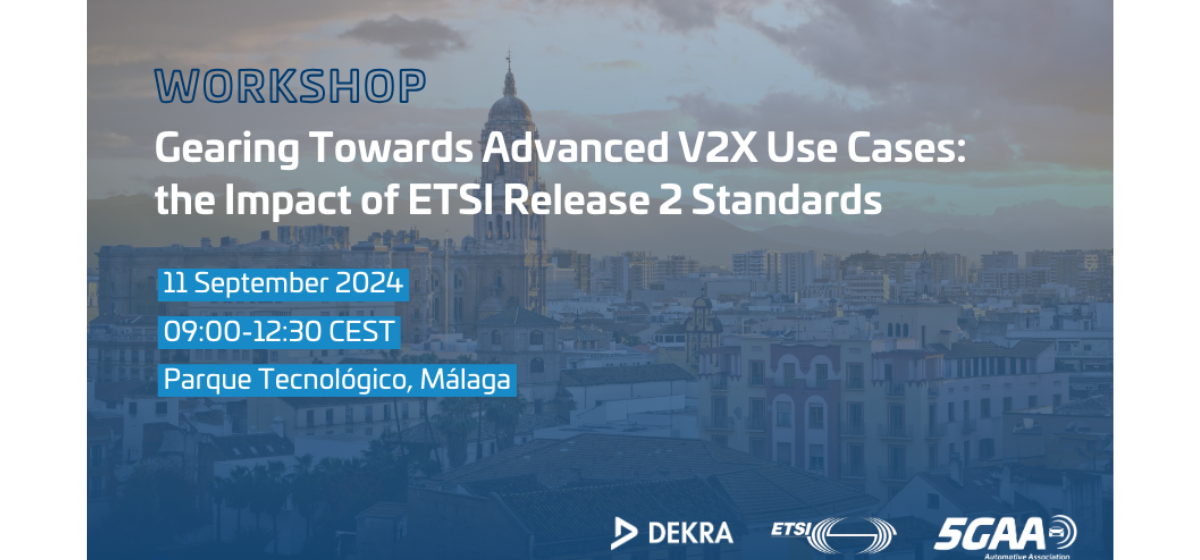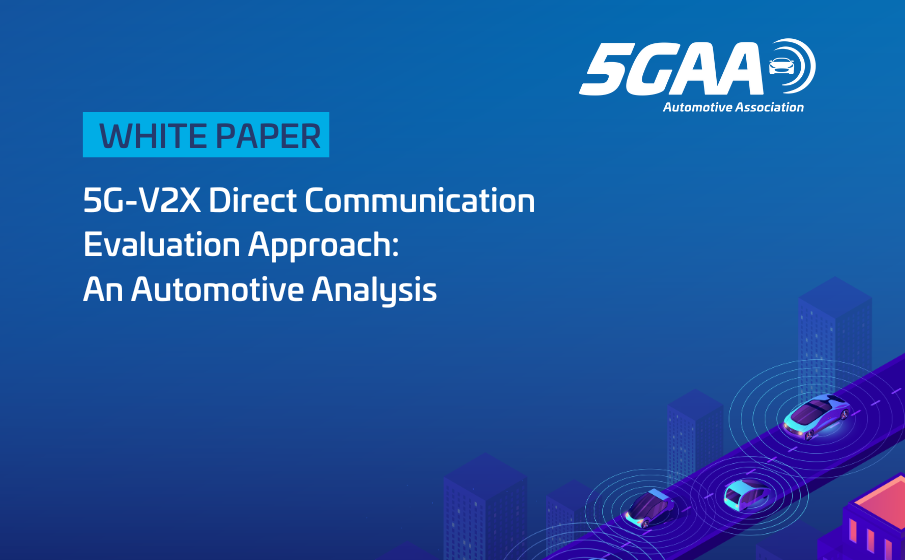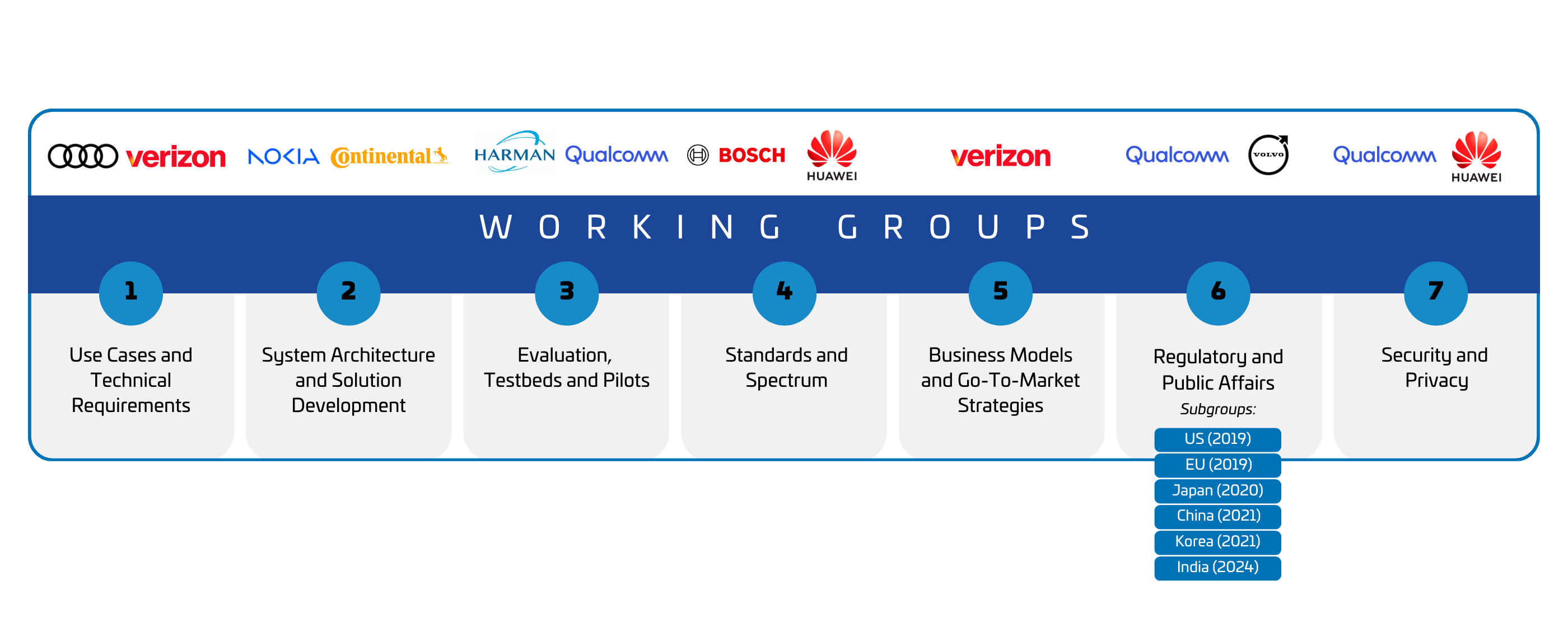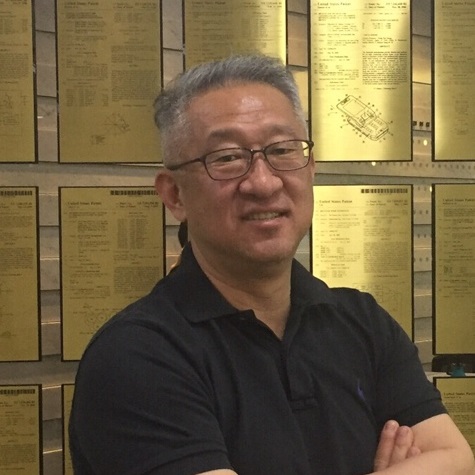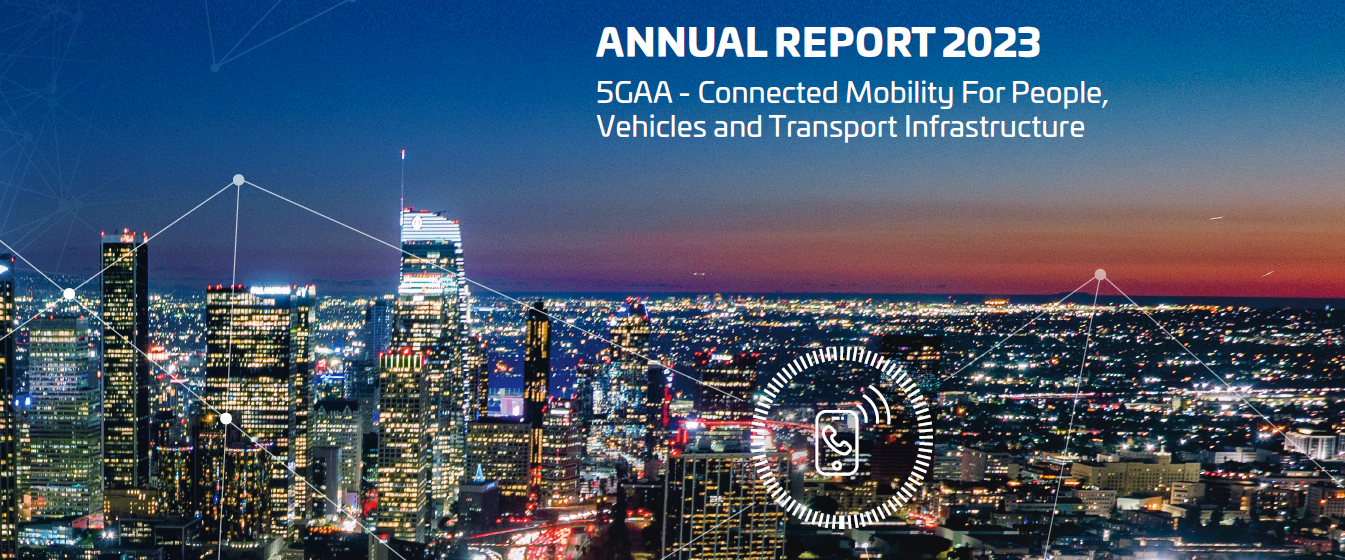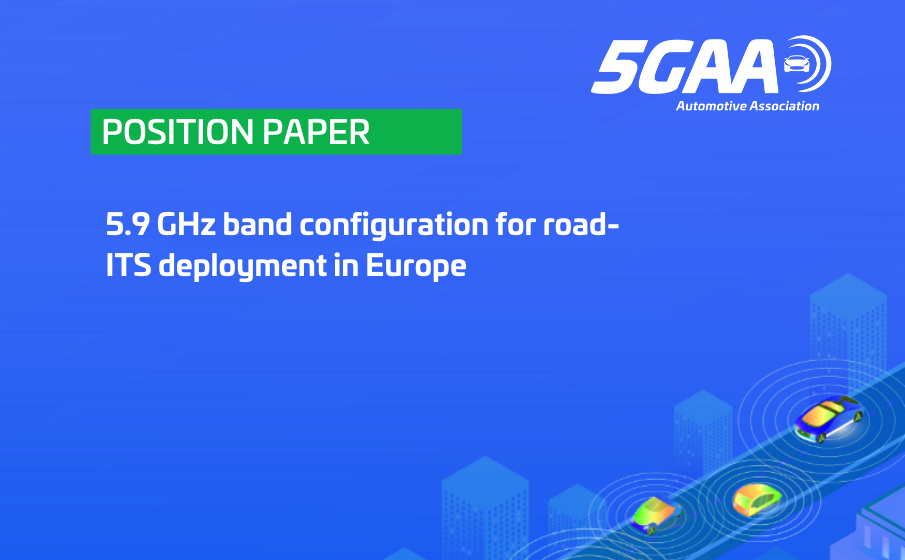The 5GAA – 5G Automotive Association e.V. (5GAA) places great importance on the protection of your personal data and is committed to comply with all applicable data protection laws and regulations.
The following Privacy Notice will provide you with information about the personal data we collect, process and use when you visit 5GAA’s website, become a member of the association, otherwise use our services or when we interact or communicate with you in any other way. Please note that if you use services provided by third parties, only the Privacy Notice of these third parties shall apply to the personal data processed via these services.
1. Who is responsible for the processing of your personal data?
The responsible data controller, that means the entity deciding why and how to process your personal data, is:
5GAA – 5G Automotive Association e.V.
Neumarkter Str. 21
81673 Munich (Germany)
Tel.: + 49 89 54 90 96 80
Fax: + 49 89 54 90 96 85
secretariat@5gaa.org
5GAA is a global, cross-industry organization of companies from the automotive, technology, and telecommunications industries (ICT), working together to develop end-to-end solutions for future mobility and transportation services.
2. What personal data do we collect?
We collect information from you when you use our website, complete our “Contact us” form, apply to join the association or to cooperate with us in any other way, are a member of the association, join or participate in our working groups, register for an event or otherwise interact with us. We may also receive information on you from our member companies and institutions that you are associated with (for example as an employee).
The personal data we collect might include your title, first name, surname, gender, date of birth, address, email address, phone number, IP address, and information regarding what pages are accessed and when.
We may also collect information relating to your employment, including where you are currently employed, your job title, areas of interest/expertise and your job function if this is relevant to your interaction with us. In applications for some categories of membership we ask you to identify a reference by providing their name and address. Please make sure that you have obtained the consent of the reference prior to providing the contact details.
We may also collect your personal data (e.g. name, email address, organisation, function, other relevant contact data), in particular with respect to your function as policymaker or representative of the media or of a public authority, from publicly available sources or within the scope of our business activities from our external sources.
3. For which purposes do we process your personal data?
We process your personal data for the following purposes:
- Processing your application, in particular for a membership with 5GAA;
- Administering your membership, that means where we have to process your personal data to perform our relationship with you;
- Handling your requests and reacting to other interactions initiated by you;
- Processing your invitations for 5GAA or associated events to facilitate your attendance;
- Compiling statistics, insights and analyses of attendance and success of our events;
- Coordinating the activities of 5GAA, and, in particular, its working groups;
- Enabling 5GAA members, their delegates and other working group participants to communicate (e.g. via email) and to cooperate with you with regard to your working group activities or mutual interests;
- Seeking your views or comments in the context of 5GAA’s activities;
- Sending you communications which you have requested or that may be of interest to you, including newsletters, press releases, position papers, information about events and other activities of the association; requests for feedback on our events;
- Monitoring compliance with our terms and policies, for example, to prevent or detect fraud or other crimes;
- For billing purposes, where necessary.
4. Who has access to your personal data?
To support us with the administration of your membership and the coordination of our activities (such as hosting and organizing events), our service provider MCI Deutschland GmbH will access and process your personal data on our behalf.
In addition, we will disclose your personal data to our third-party service providers, agents, subcontractors and other associated organizations for the purposes of completing tasks and providing services to you on our behalf. These service providers include, for example, fulfilment providers for delivery of our digital content and newsletters; member service agencies; hosts, organizers and sponsors of our events; organizations that host our website or databases; and providers of online surveys. We may also disclose your personal data to legal consultants or similar third parties where this is necessary for our legitimate interests, for example for the prevention or detection of fraud or other crimes. However, when we share your personal data with third parties, we disclose only the personal information that is necessary to deliver the services and we have contracts that require them to keep your information secure and not to use it for their own purposes.
If you subscribe to a mailing list of a working group, we may disclose your personal data, in particular your name, the name of the organisation that you are representing, your job title and your email address to other delegates or participants of the same or similar working groups.
Where we are required by applicable laws, we will also disclose your personal data to law enforcement, government authorities or courts.
We will not sell or rent your information to third parties unless you have given your express consent for us to do so where required by law.
5. On which legal basis do we process your personal data?
We will process your personal data on the following legal bases under Article 6 of the EU General Data Protection Regulation:
- Application and membership necessity: Where the processing of your personal data is necessary to manage your application and administer your membership or any other association with 5GAA;
- Legitimate business purposes: Where the processing is necessary for our legitimate interests (such as to protect us from harm by preventing or detecting illegal activities, fraud or similar threats; to represent our interests publicly or among experts, in particular by reaching out to and communicate with media representatives, policymakers, public authorities and other associations or organizations; to exercise or defend against legal claims; to enhance the benefit of a 5GAA membership by enabling networking and cooperation activities amongst our members, their delegates and other stakeholders; to improve our future events and better meet the interests of our members by compiling statistics, insights and analyses of attendance at our events; or to analyze our website usage and services), unless we determine in a case-by-case assessment that our interests are overridden by your interests or rights;
- Legal obligation: To comply with legal obligations to which we are subject (for example, where we are requested by a court to disclose your data);
- Consent: This is where you have given us explicit permission to process personal data for a given purpose, as required under applicable data protection laws and regulations. For example, we will ask for your consent to receiving newsletters when you sign up on our website.
6. Where will your personal data be processed?
Your personal data will be processed both inside the European Union (“EU”) and the European Economic Area (EEA) and outside by the parties specified in Section 4 above.
Please note that EU / EEA Member States and other countries all have different laws regarding the protection of personal data. If we transfer your personal data from your own country to another country, the laws and rules that protect your personal data in the country to which your information is transferred to can be different (or less protective) from those in the country in which you live.
If we transfer any of your personal data outside the EU or EEA, we will, to the extent that this is required by applicable data protection laws and regulations, ensure that the recipient of the personal data provides for an adequate level of data protection, in particular, by implementing safeguards such as standard contractual clauses approved by the European Commission or by relying on an adequacy decision by the European Commission. Further information can be found here: https://ec.europa.eu/info/law/law-topic/data-protection/data-transfers-outside-eu_en.
7. Cookies
In order for this site to work properly, we sometimes place small data files called cookies on your device.
What are cookies?
A cookie is a small text file saved on your computer or mobile device by a website when you visit https://5gaa.org/. The cookie enables the website to remember your actions and preferences such as login, language, font size and other display preferences to keep you from having to reenter them on every visit to the website or when browsing from page to page.
How do we use cookies?
A number of the pages on our website use cookies to remember:
- Your display preferences, such as contrast and colour settings or font size.
- Whether or not you have already replied to a survey popup that asks you if the content was helpful or not so that you won’t be asked over and over again.
- Whether or not you have agreed to our use of cookies on this site.
In addition, some embedded videos in our pages use a cookie to anonymously gather statistics on how you got there and what videos you viewed. Although enabling these cookies is not strictly necessary for the website to work, it will provide you with a better browsing experience. Cookies can be deleted or blocked, but some features of this site may not work as intended should you do so. The cookie-related information is not used to identify you personally and the pattern data is fully under our control. The cookies on this website are not used for any purpose other than those described here.
How to control cookies
You can block and/or delete cookies as you wish using your browser settings. You can delete all cookies that are already on your computer and you can set your browser to prevent them from being placed. By doing this you may have to manually adjust some preferences every time you visit https://5gaa.org/ and some services and functionalities may not work.
8. How do we protect your personal data?
5GAA maintains appropriate technical and organizational security measures designed to protect your personal data against accidental, unlawful or unauthorized destruction, loss, alteration, access, disclosure or use.
Non-sensitive details (your email address etc.) are transmitted normally over the Internet, and this can never be guaranteed to be 100% secure. As a result, while we strive to protect your personal data, we cannot guarantee the security of any information you transmit to us, and you do so at your own risk. Once we receive your personal data, we make our best effort to ensure its security on our systems. Where we have given (or where you have chosen) a password which enables you to access certain parts of our website, you are responsible for keeping this password confidential. We ask you not to share your password with anyone.
9. How long do we store your personal data?
We will not retain your personal data longer than necessary to fulfil the purposes the data was collected for or to fulfil our legal obligations. Afterwards, we will delete your personal data.
If you wish to receive further specific information on the applicable retention periods, please contact us under the contact details mentioned in Section 11.
10. What are your rights in respect of your personal data?
To the extent permitted by applicable data protection laws and regulations, you have the right to access your personal data that we hold on you, to update or correct your data so that it is always accurate and to request the deletion of your personal data if it is no longer needed for the purposes above. Furthermore, you have the right to restrict the processing of your data in certain circumstances (for example, where you have contested the accuracy of your data, for the period enabling us to verify its accuracy) and to obtain a copy of your personal data (including in an electronic, machine-readable format).
Moreover, you have the right to withdraw your consent at any time where your personal data is processed with your consent, without affecting the lawfulness of processing based on consent before its withdrawal.
You also have a right to object to the processing of your personal data:
In the event and to the extent that we process your personal data based on our legitimate interests as mentioned above, you have the right to object to the processing on specific grounds relating to your particular situation. In such case we will no longer process your personal data unless we have compelling legitimate grounds for the processing which override your interests, rights and freedoms or for the establishment, exercise or defense of legal claims.
In the event and to the extent that we process your personal data for direct marketing purposes, you have the right to object at any time to processing of your personal data for such marketing.
Please note that legal exceptions (such as mandatory retention periods or rights of third parties) may limit your rights.
To exercise your rights, please reach out to us via the contact details mentioned in Section 11.
You also have the right to lodge a complaint with a competent data protection supervisory authority.
We welcome any queries and complaints you may have regarding how we process your personal data via e-mail to secretariat@5gaa.org or in written form to 5GAA – 5G Automotive Association e.V. – Head Office, Neumarkter Str. 21, 81673 Munich (Germany).
12. How often do we update this privacy notice?
This privacy notice will be updated to reflect changes either regarding the way in which we process your personal data or changes to data protection legislation. We will bring any significant changes to your attention by updating this information and making it available on our website. To make sure that you keep up to date, we suggest that you revisit this notice from time to time. In addition, we will examine whether in individual cases there is an obligation to provide other notification in the event of any changes to this information and in this case, we will comply with the existing notification obligation.
This Privacy Notice was last updated in January 2021.


